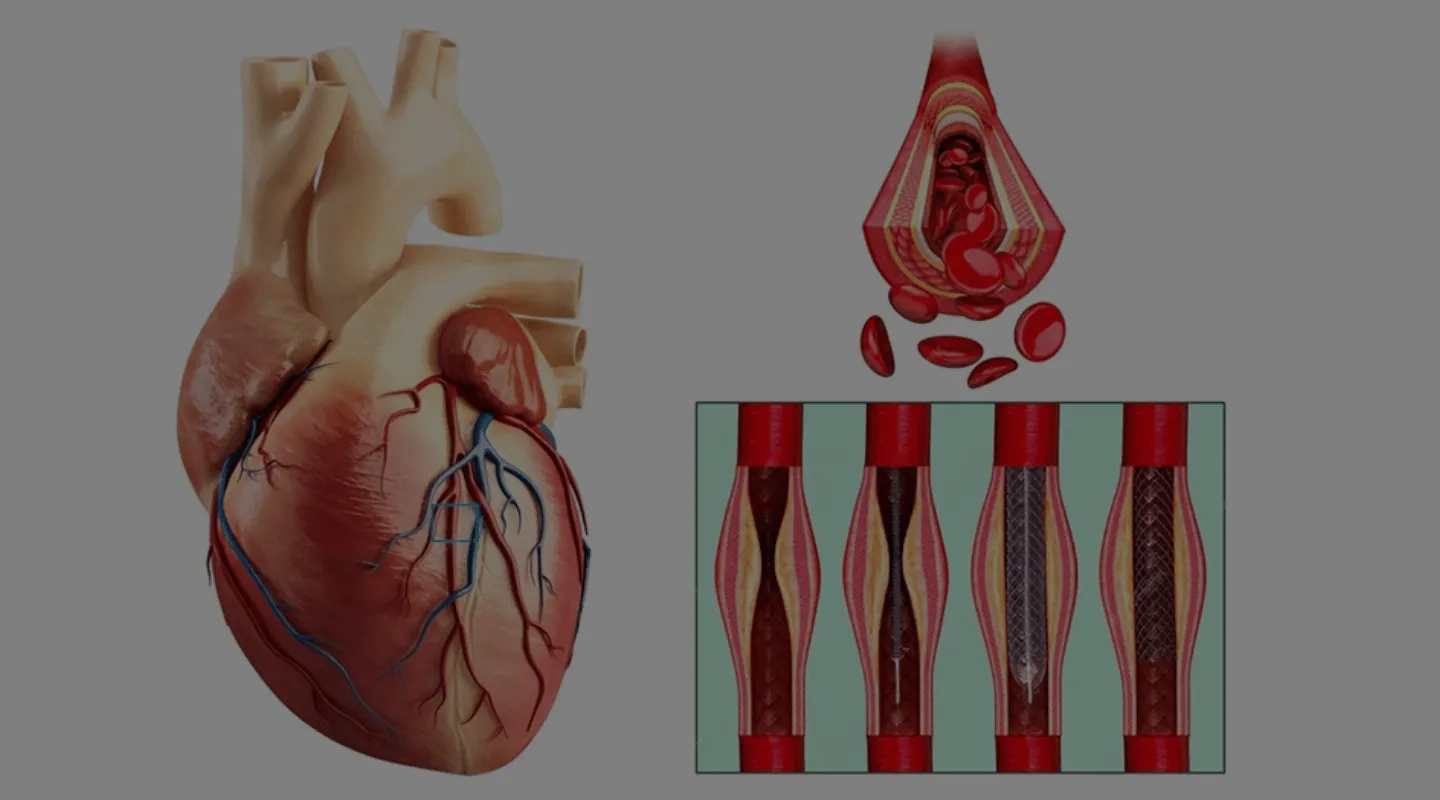
Angioplasty
Your Angioplasty in Tunisia at an affordable price
High-precision care in a secure and well-equipped environment. Opt for a medical stay with Tunisia Destination Santé and benefit from the expertise of our specialist doctors and the best healthcare facilities in Tunisia.
How does it work?
What is angioplasty in Tunisia?
Angioplasty is a treatment performed to address a blocked coronary artery. It involves inserting a balloon into the artery to widen it, restoring efficient blood flow. Additionally, the cardiologist may also use a stent, which acts like a small spring to keep the artery open and prevent future blockage. Some modern stents, known as drug-eluting stents, release substances that benefit the arteries, providing better protection against recurrence. One of the great advantages of stents in treating coronary artery disease is that they do not require surgery for removal. Indeed, after a few years, these small devices naturally dissolve and disappear from the patient’s body without leaving a trace.
Who is coronary angioplasty for?
Coronary angioplasty primarily targets patients with coronary artery disease, such as stable or unstable angina and myocardial infarction. This procedure is recommended when the coronary arteries, which supply the heart with oxygen-rich blood, are narrowed or blocked by atherosclerotic plaque deposits. Ideal candidates for coronary angioplasty are those who experience symptoms such as chest pain, shortness of breath, or reduced exercise tolerance due to insufficient blood flow to the heart. Furthermore, angioplasty may be indicated if drug treatments aimed at managing the symptoms of coronary artery disease fail. This procedure is also considered in emergency situations, such as during a heart attack, to quickly restore blood flow and minimize damage to the heart muscle. In short, coronary angioplasty is intended for patients with significant clinical signs of coronary artery disease to relieve symptoms, improve quality of life, and reduce the risk of serious cardiac complications.
What are the objectives of angioplasty in Tunisia?
The main objective of angioplasty is to restore good blood circulation in the coronary artery. The diagnostic phase, performed using coronary angiography, allows for precise localization of areas where the artery is narrowed, called coronary stenosis. Angioplasty is then performed as a treatment to restore good blood flow in the patient. It is performed on patients suffering from coronary artery disease in order to prevent the progression of the disease and avoid the risks of complications and myocardial infarction. It can be undertaken to treat two different situations. First, it can be performed in patients with stable coronary artery disease. Second, it can be used in emergency situations to unblock an artery in patients suffering from acute coronary syndrome, which is characterized by the sudden blockage of a coronary artery. In the latter case, it is a rescue angioplasty that must be performed within hours of the onset of symptoms to prevent a heart attack. For patients with stable coronary artery disease, there is no rush and angioplasty can be calmly discussed and planned with the cardiologist. The patient will then have time to properly prepare for the procedure, particularly psychologically.
Angioplasty recovery time
Recovery time after angioplasty is generally short, allowing patients to resume their daily activities relatively quickly. Most patients can expect to spend one night in the hospital for observation after the procedure, although some may be discharged the same day. During the first few days following angioplasty, it is crucial to rest and avoid strenuous physical activity to allow the treated artery to heal properly. Patients can usually resume light activities, such as walking, within two to three days, but should avoid lifting heavy objects or vigorous exercise for about a week. It is also important to follow medical recommendations regarding the use of antiplatelet medications to prevent the formation of clots in the treated artery. Follow-up visits with the cardiologist are essential to monitor the healing progress and adjust treatment if necessary. By adopting a healthy lifestyle, including a balanced diet, regular exercise, and stress management, patients can improve their recovery and reduce the risk of future complications.
What is the price of angioplasty in Tunisia?
By opting for angioplasty in Tunisia, you will benefit from an intervention performed at an advantageous rate, as well as in highly qualified medical facilities. Our packages include clinic fees and all expenses necessary for your angioplasty. Contact us for more details.
Your health, our priority.
Request your free quote.
Your angioplasty in Tunisia in an ultra-modern medical setting
During your transluminal angioplasty in Tunisia, you will be cared for by an experienced and highly qualified cardiologist working in a fully equipped clinic with state-of-the-art equipment. Our dedicated medical staff will be attentive to your needs, and you will have access to a multidisciplinary team composed of experts in anesthesia, resuscitation, and more. With Tunisia Destination Santé, you can trust in our quality care and our efforts to ensure your safety and well-being.
Your angioplasty following a coronary angiography
Following a coronary angiography, the cardiologist may recommend stent placement. Take advantage of your stay in Tunisia to have an angioplasty following a coronary angiography and return home with confidence. If you have already had a coronary angiography at home and would like to have an angioplasty in Tunisia, the cardiologist will in this case recommend a coronary angiography followed by an angioplasty. Contact us for more information.
What are the complications associated with coronary angioplasty?
Coronary angioplasty is commonly considered a safe procedure. It allows for the unblocking of arteries and improves blood supply to the heart muscles. Rarely, the blockage may reappear. The cardiac catheterization procedure involves eliminating blockages in the arteries using small, sturdy balloons attached to thin tubes called catheters. These are inserted through the blood vessels of the wrist or groin, while under continuous radiographic imaging. This takes place in a special room called a cardiac catheterization laboratory. In order to prevent the formation of clots in the blood vessels after angioplasty, medications are used before, during, and after the procedure, while carefully monitoring blood clotting. These measures ensure the smooth running of the procedure and minimize risks for the patient. Very rarely, the blood vessel may be perforated during the procedure. This can cause bleeding into the lining of the heart called the pericardium. If severe, it can compress the heart and lead to a drop in blood pressure. Meticulous attention to angioplasty technique is the way to minimize this complication. Perforations can be sealed using tissue-covered stents implanted in the blood vessel.
Angioplasty success rate
Angioplasty, a commonly used procedure to treat coronary artery disease, has a high success rate of approximately 90%. This percentage reflects the effectiveness of angioplasty in restoring blood flow to the heart by widening blocked or narrowed coronary arteries. Thanks to advanced technologies and improved techniques, most patients undergo this procedure successfully, experiencing a significant reduction in symptoms such as chest pain and shortness of breath. In addition, angioplasty helps improve patients’ quality of life and reduce the risk of future serious cardiac events, such as heart attacks. However, as with any medical intervention, there are possible risks and complications, although these are relatively rare. The success rate may vary depending on individual factors, such as the patient’s general health, the severity of coronary artery disease, and the precision of the technique used. Close collaboration with qualified healthcare professionals and adherence to post-operative recommendations are essential to maximize the chances of angioplasty success and ensure optimal recovery.
Our advantages


Contact and request a quote for angioplasty
If you are considering having angioplasty abroad, choose a reliable and experienced agency to organize your stay in Tunisia. With Tunisia Destination Santé, count on our team to accompany and guide you every step of the way. We will assist you in preparing your file and scheduling your trip. Contact us now to obtain additional information and a free quote without obligation for your angioplasty.
—
Frequently Asked Questions
Yes, angioplasty can also be used to treat peripheral vascular disease, renal artery stenosis, and certain carotid artery obstructions.
Intravascular imaging, such as intravascular ultrasound (IVUS) or optical coherence tomography (OCT), allows detailed visualization of the inside of blood vessels, helping cardiologists accurately assess lesions and choose the best approach for treatment.
Advanced techniques such as the use of specialized guidewires, perforation devices, and stents dedicated to bifurcations allow these complex lesions to be treated with greater precision and success.
Diabetic patients have an increased risk of complications such as restenosis, infection, and slower healing. Strict blood glucose management and intensive follow-up care are essential to minimize these risks.
Bioabsorbable stents, which dissolve in the body after keeping the artery open, and new-generation drug-eluting stents, which release drugs to prevent restenosis, represent major advances.
Post-angioplasty antithrombotic and antiplatelet treatments are increasingly personalized, with new classes of drugs offering better protection against blood clots while reducing the risk of bleeding.
Yes, angioplasty can be performed using alternative techniques such as intravascular ultrasound (IVUS) or optical coherence tomography (OCT) to visualize vessels without the need for iodine contrast.
Cardiac rehabilitation is crucial for improving recovery, strengthening the heart, and reducing future risks. It includes supervised exercise, nutritional advice, and risk factor management.
Yes, techniques such as intravascular lithotripsy (IVL) or rotational atherectomy can be used to treat severe calcifications before performing angioplasty.
Remote monitoring allows continuous monitoring of vital signs and symptoms, facilitating rapid intervention in the event of complications and improving adherence to treatment and long-term care management.
